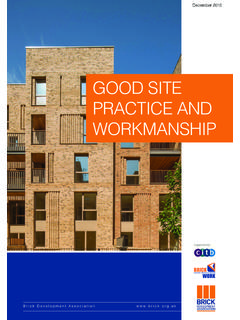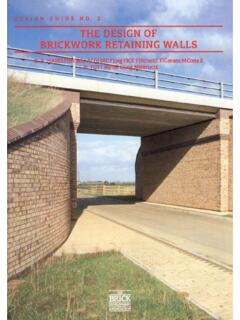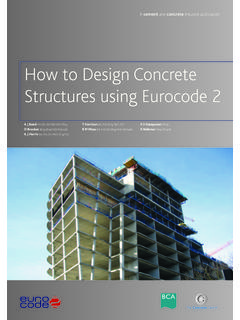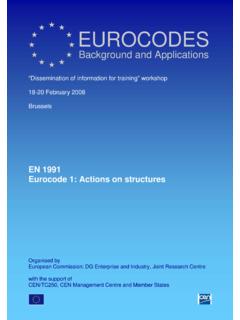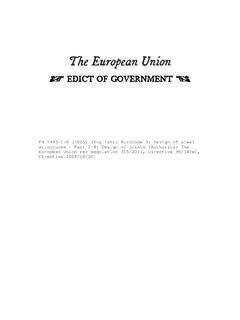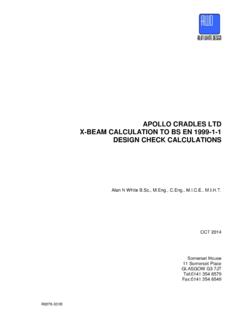Transcription of 1. Introduction to Eurocode 6 - Brick
1 How to design masonry structures using Eurocode 6. 1. Introduction to Eurocode 6 Revision 2. Eur Ing, Prof. J J Roberts BSc(Eng), PhD, CEng, FIStructE, FICE, FIMS, FCMI, MICT O Brooker BEng, CEng, MICE, MIStructE. Guidance on Eurocode 6. Introduction This publication is part of a series of three The purpose of this series of guides is to introduce designers to the basic guides entitled How to design masonry structures approach adopted in Eurocode 6. This is the first guide in the series of three using Eurocode 6. The aim is to make the use of and provides: Eurocode 6, Design of masonry structures as easy A brief outline of the scope of Eurocode 6.
2 As possible by drawing together in one place key An Introduction to design, including fire resistance and movement. information and commentary required for the Assessment of actions and combination of actions using Eurocode *. design of typical masonry elements. How to specify mortar and masonry units. Glossary of Eurocode 6 terms. The Concrete Centre (and, originally, The Modern The second guide in the series, Vertical resistance1, explains how to design Masonry Alliance) recognised that effective for vertical actions, whilst the third guide, Lateral resistance2, covers the guidance was required to ensure that the UK design of laterally loaded masonry panels.
3 Further information on Eurocode 6. design profession was able to use Eurocode 6 can be found at quickly, effectively, efficiently and with confidence. Therefore a steering group, with members from across the masonry industry (see back cover for a Eurocode 6. list of members), was established to oversee the Eurocode 6 comprises the following parts: development and publication of the original guides. Part 1 1, General rules for reinforced and unreinforced masonry structures3. Part 1 2, Structural fire design4. This second revision addresses the publication of Part 2, Design considerations, selection of materials and execution of masonry5.
4 PD6697 in 2010 and revised National Annex to Part 3, Simplified calculation methods for unreinforced masonry structures6. BS EN 1996-1-1 in 2013. It was overseen by a Each part also has a National Annex (NA) which provides the Nationally reconstituted steering group from industry (see Determined Parameters (NDPs) to be used in the application of Eurocode 6 in back cover). the UK. The UK NDPs have been used throughout this guide. In addition PD 6697 contains useful guidance complementary to Eurocode 67. This series concentrates on Eurocode 6, Part 1 1 but includes material from Part 2 to explain the exposure and durability requirements.
5 The scope and content of Part 1 2 and Part 3 are also briefly explained. Eurocode 6 is intended to be used with Eurocode *: Basis of structural design8, Eurocode 1: Actions on structures9 and, where appropriate, the other Eurocodes and relevant European Standards. The guide Introduction to Eurocodes10. provides more information on the Eurocode family. Eurocode 6 has been developed to enable the designer to use the following types of masonry unit: clay, calcium silicate, aggregate concrete, autoclaved aerated concrete (aircrete), manufactured stone and natural stone. European standards for these materials have been published by BSI and form part of an array of standards relating to masonry produced under the auspices of the European Committee for Standardisation (CEN), committee TC/125 (Masonry).
6 *BS EN 1990 is entitled Eurocode ', but is often referred to as Eurocode 0. How to design masonry structures using Eurocode 6. Scope of Part 1 1 of Eurocode 6. Part 1 1 describes the principles and requirements for safety, Basis of design serviceability and durability of masonry structures. It is based on the Masonry structures are required to be designed in accordance with the limit state concept used in conjunction with a partial factor method. general rules given in Eurocode , which requires that: For the design of new structures, BS EN 1996 1 1 is intended to be Ed Rd used together with the other relevant Eurocodes.
7 Where Scope of Part 1 2 of Eurocode 6 Ed = design value of the effect of actions Rd = design value of the resistance This part deals with the design of masonry structures for the accidental situation of fire exposure and identifies differences from, The basic requirements of Section 2 of Eurocode are deemed to be or supplements to, normal temperature design. Only passive methods satisfied for masonry structures when the following are applied: of fire protection are considered and active methods are not covered. Limit state design in conjunction with the partial factor method It addresses the need to avoid premature collapse of the structure described in Eurocode .
8 And to limit the spread of fire. Actions as given in Eurocode 1. (See Assessment of actions' below.). Combination rules as given in Eurocode . Scope of Part 2 of Eurocode 6 The principles and application rules given in Eurocode 6. This part gives the basic rules for the selection and execution of masonry to enable it to comply with the design assumptions Thus using the partial factor method, the design value for a material of the other parts of Eurocode 6. It includes guidance on factors property is obtained by dividing its characteristic value by the relevant affecting performance and durability, storage and use of materials, partial factor for materials as follows: site erection and protection, and the assessment of the appearance R.
9 Of masonry. Rd = g k M. where Scope of Part 3 of Eurocode 6. Rd = design value of resistance This part provides simplified calculation methods to facilitate the Rk = characteristic value of the resistance design of a range of common wall types under certain conditions of gM = partial factor for a material property use. The methods are consistent with Part 1 1 but result in more conservative designs, and other methods are available in the UK; see 'Simplified calculation methods' on page 7. The simplified methods are not applicable to design for accidental situations, which should be Partial factors for materials designed for in accordance with CI of Part 1 1.
10 The partial factors for use with masonry are given in Table of the National Annex to Eurocode 6, Part 1 1 and shown here as Table Scope of PD 6697 1. Two levels of attestation of conformity are recognized, Category I. This Published Document contains non-contradictory complementary and Category II and this will be declared by the manufacturer of the information and additional guidance for use in the UK with Part 1-1 masonry units. There are also two classes of execution control that are and Part 2 of Eurocode 6. recognized: 1 and 2. Supporting standards Assessment of actions There are European Standards that support Eurocode 6, and The Eurocodes use the term action to refer to a set of forces, whilst they were developed within a common framework, it has deformations or accelerations acting on the structure; this includes not proved possible to standardise all the test methods used for horizontal and vertical loads.

